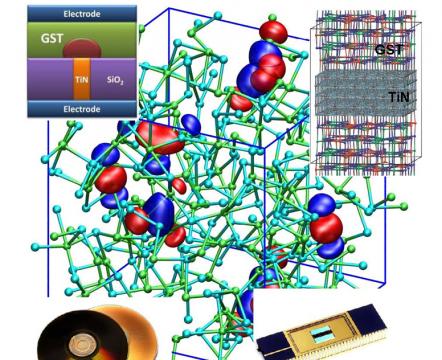First Principles Simulations of Materials for Microelectronics
Phase Change Materials for Data Storage and Neuromorphic Computing

Phase change materials (Ge2Sb2Te5 and related telluride alloys) are exploited for applications in non-volatile electronic memories (phase change memories, PCM), and in devices for neuromorphic computing. Both applications rely on a fast (10-100 ns) and reversible transformation between the crystalline and amorphous phases induced by Joule heating. The two states of the memory can be discriminated thanks to the large contrast in electronic conductivity between the two phases.
Based on density functional molecular dynamics simulations, we investigate the structural, dynamical and electronic properties of the amorphous and crystalline phases of materials in this class aiming at establishing correlations between the composition of the alloy and the functional properties exploited in the devices.
Large scale molecular dynamics simulations are also performed by developing interatomic potentials generated by fitting a large DFT database with machine learning Neural Network methods. The Neural Network potentials allow simulating several key features of these materials such as the crystallization kinetics and the thermal transport and the real time and length scales of the operation of the memory devices.
Surface Phonons and Topological Insulators
Some chalcogenide compounds of interest for phase change applications belong to the class of topological insulators, i.e. they are bulk insulators with a non-trivial topology of the electronic bands which induces the formation of topologically protected metallic electronic bands at the surface. Based on density functional perturbation theory, we study the surface phonons and the electron-phonon interaction of materials in this class as well as in other semiconducting and metallic materials also by comparing the theoretical results with measurements from He-atom scattering from various experimental groups in Europe we collaborate with.
High-throughput Studies of Low-dimensional Systems
Low dimensional systems (2D or 1D) are regarded as promising alternatives to silicon in new generation electronic devices and as innovative solutions in the field of quantum computing. Exploiting high-throughput calculation techniques, i.e. the study from first principles of hundreds or even thousands of materials at a time, we search the materials best suited to a target application with a particular emphasis on the transport and electron-phonon characterization.
Research Group
Prof. Giorgio Benedek
Prof. Marco Bernasconi
Dott. Davide Campi
Lab
U5 building, Basement floor, Server room